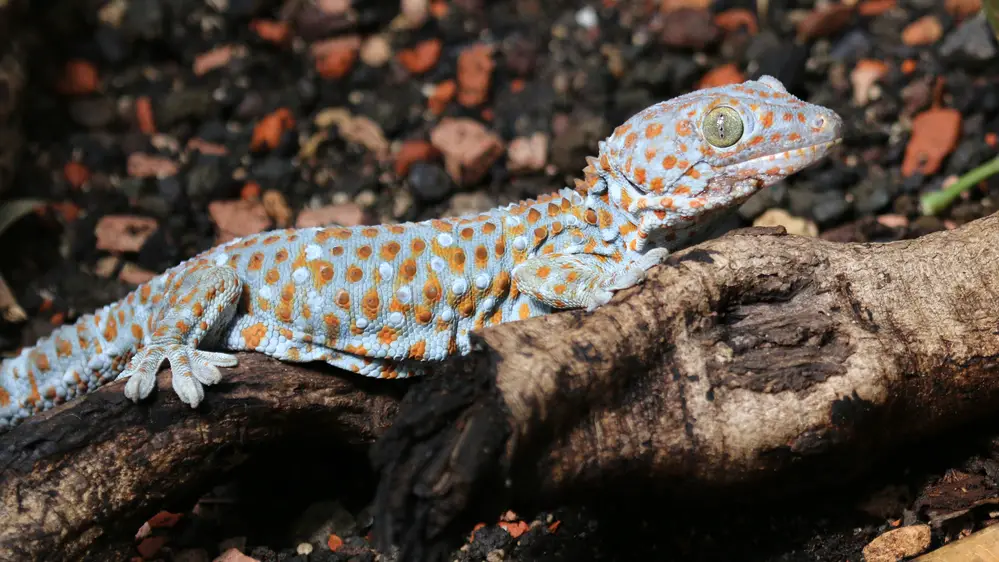Tokay Geckos are one of the largest living species of Geckos and have become great additions as pets to households across America and worldwide. A common question concerning these pets is, how long can Tokay Geckos go without eating?
Adult Tokay Geckos can typically go up to two or three days without eating, whereas younger Tokay Geckos need to be fed daily. Their diet includes a mixture of insects, dry food, and mice.
This article will discuss how long Tokay Geckos can go without eating. So keep reading! We have everything you need to know about how long tokay geckos can go without eating.
How Long Can Tokay Geckos Go Without Eating?
Tokay geckos are large, nocturnal lizards native to Southeast Asia. They are well-known for their voracious appetites and can eat up to three times their body weight in a meal.
However, these geckos can also go for long periods without food. In the wild, these lizards may only encounter a meal once every few days, and they have been known to survive for over two months without eating.
In Captivity
In captivity, Tokay geckos will typically eat every day or every other day. However, if food is scarce, they can go for weeks without eating. This ability to survive without food is likely an adaptation that helps these lizards survive lean times in the wild.
When it comes to feeding your Tokay Gecko and how long they can go without eating, you should remember that at different stages of their life, and depending on their size, they will require different amounts of food.
- Baby Tokay Geckos: If your Tokay is anywhere from 0 – 6 months old, they must be fed around two or three times per day. Their diet should consist of extra small feed and a small amount of diet food.
- Juvenile: If your Tokay Gecko is aged anywhere from 6 months to 1 year, then you can begin to reduce their meals to one per day. This is an excellent time to start increasing the size of the meals from tiny insects to medium-sized ones.
- Adult: By the time your Tokay Gecko gets to over a year old, they need to be fed every two to three days. Here you can begin to provide them with more giant insects and introduce some small prey items into their diet. This can be accompanied by a more significant amount of commercial diet food.
If you’re curious about how much your Tokay Gecko needs to be fed depending on its size, you can contact a veterinarian or your local exotic pet store.
What Should I Feed My Tokay Gecko?
Tokay Geckos can have a good appetite for their size and should be fed a variety of insects, including mealworms, super worms, crickets, waxworms, cockroaches, and grasshoppers.
Once your Tokay Geckos reach adulthood at around a year old, you can add some pinky mice to their diet. Be sure not to overfeed them mice, as this can lead to gout from too much protein.
The prey you give to your Gecko should be fed nutritious food so that the nutrition is passed on when your Tokay eats them. The game can also be dusted with supplements such as a multivitamin containing calcium.
There are also pre-packaged foods available for your Tokay Gecko. These are formulated by nutrition experts to provide your Gecko with a wide range of nutrients and can help supplement their diet with the vitamins not available through other food.
When it comes to water, you usually don’t have to worry about your Tokay Gecko. Just as they would in the wild, your Gecko will drink the moisture droplets that build up on branches in its enclosure. You should still add a small water dish in their tank just so that they always have a source of fresh water.
What To Do If My Tokay Gecko Isn’t Eating?
If you realize that your Tokay Gecko has stopped eating, it’s usually due to something they’ve done or eaten, leading to an illness. Before you begin to panic, you should know a few things before you rush your Tokay to the Veterinarian.
One fairly common reason that your Tokay has stopped eating is that they are too cold. This can happen if the health bulb in its tank has burned out, the heat mat has stopped working, or there may even be a bit of a draft getting into the tank.
Your Tokay may stop eating if it has recently injured itself. Tail and toe problems and eye injuries will make your Tokay uncomfortable, resulting in a lack of appetite. If your Gecko is still moving around, one of these factors may have caused it to stop eating, and you can wait a few days to see if its condition gets better before you take it to the vet.
Suppose your Tokay Gecko has recently gotten sick from a chill or a draft that has dropped their environmental temperature. In that case, this can lead to a respiratory infection that will undoubtedly cause them to stop moving around and lose their appetite. Respiratory infections are relatively common in reptiles. If this is the case, it’s probably best to take your Tokay to the vet for a proper analysis.




